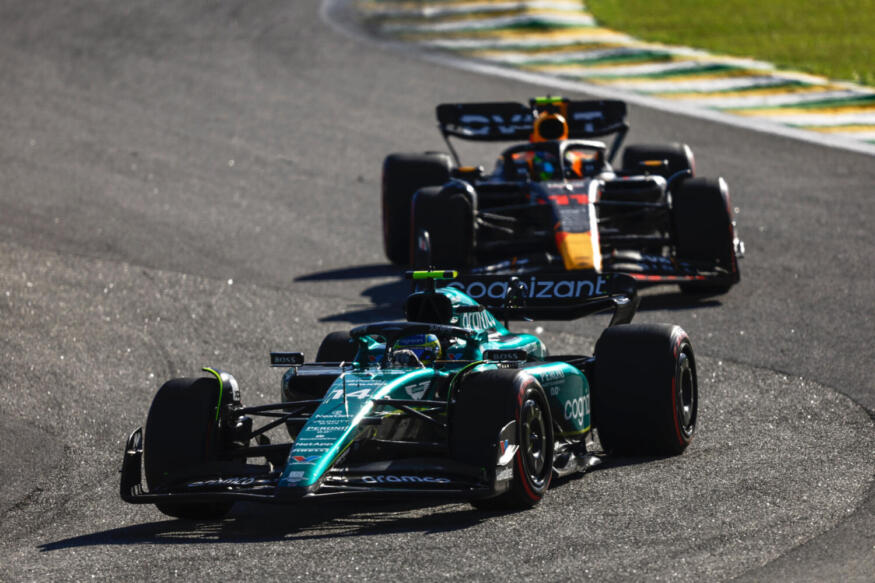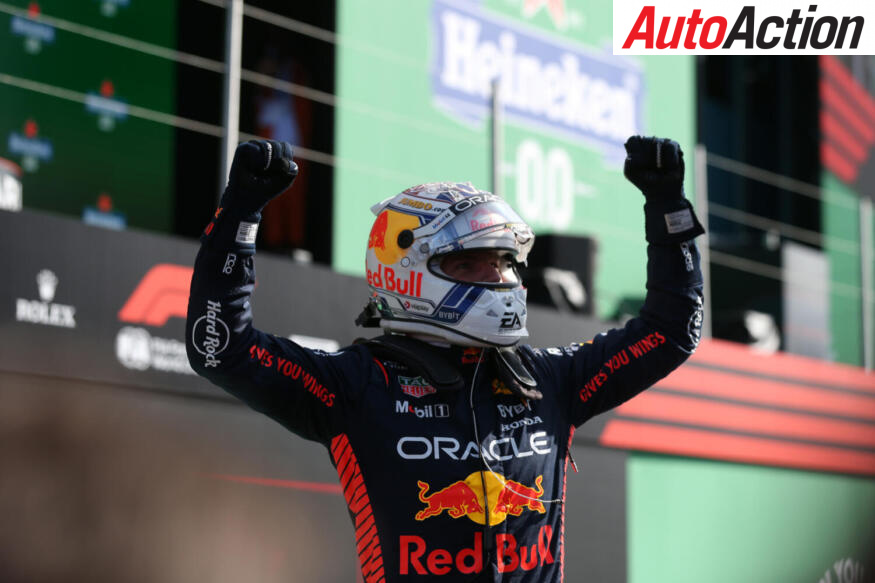Formula 1 reflection: The good, the bad and the ugly

By Luis Vasconcelos
Date posted: 3 January 2024
As the new year arrives, it is time to look back at what was a very intense 2023 Formula 1 World Championship on and off the track.
Also analyse what was good for the sport and the fans, what was not so positive, and what was downright negative and shouldn’t be repeated.
For me, the best thing about the season was how close the entire field was, especially in qualifying.
No one, not even Verstappen, could take it easy and run harder tyres in Q1 to save more Softs for Q3, because it was not unusual to have all 20 drivers inside the same second.
In Austria – granted, the shortest lap of the year – the entire field ended Q1 inside 0.8s and, if you took the two Red Bulls away, the other 18 drivers were separated by just 0.4s! Now, that’s what I call a competitive field.

There was not much splitting the teams in Austria. Image: Andy Hone / LAT Images
Of course it would have been nice for Red Bull to be challenged, but in the course of the season Aston Martin, Ferrari, Mercedes and McLaren had the second quickest car in the field, so there was a big variety in the battle behind the best car.
And, occasionally, all of them managed to challenge Verstappen on occasions – Sainz winning for Ferrari in Singapore and rookie sensation Oscar Piastri winning the Sprint race in Qatar, without any misfortune hitting the Dutchman, therefore, on merit.
Another great thing was the quality of the battles at the front because, when the best drivers in the world fight cleanly, it’s a beautiful thing to see.

Fernando Alonso leads Sergio Perez in the final moments of the São Paulo GP. Image: Zak Mauger / LAT Images.
There was great overtaking for top positions and if the Alonso-Pérez battle for P3 in Brazil won the Spaniard the FIA prize, it was Charles Leclerc’s last dash pass on the Mexican, on the last lap in Las Vegas, that took my breath away.
And, still on the positives, the fact Oscar Piastri showed his speed, consistency and racecraft that are way beyond his years, proved there’s another top driver on the way – so together with Verstappen, Leclerc, Norris, Russell, Albon and Sainz there’s a generation that may be in Formula 1 for the next 10 years, way after legends like Hamlton and Alonso have retired, to keep us entertained.
Having been spoiled by arriving in Formula 1 when Senna, Prost, Piquet and Mansell were all at the top of their game, I’m really happy we finally have an even bigger group of highly talented drivers that will give us great racing in the coming years.

F1 2023 was all about one man, Max Verstappen.
The bad was, of course, the domination by one team and one driver because, after a promising start, Sérgio Pérez’s challenge faded quickly and he never recovered.
But that’s not Red Bull or Max Verstappen’s fault, because they just did their job and it’s up to the other nine teams to get their act together – the last thing the sport should do would be to try and cull the Austrian team’s technical advantage by making targeted changes to the rules to affect them.
Formula 1 is a meritocracy, so you get what you deserve and that’s how it should be.
It was also bad that Formula 1 waited for the last minute to cancel the Imola weekend, when for two days it was clear there were no conditions for the event to go ahead.
Also, especially bad, the Las Vegas schedule and putting the event one week before Abu Dhabi – making one quarter of the drivers and quite a few more people in the paddock ill, due to the time and temperature differences.

Fans were not happy to be ejected from their seats in Las Vegas. Photo by Simon Galloway / LAT Images
Ugly was the way Formula 1 dealt with the Las Vegas fans, forcing them out of the grandstands after putting together a track that was, initially, not up to the task and not even having the decency to apologise to them – believing such an apology would earn the sport a massive lawsuit.
But what has been really ugly all year is the ongoing war between Formula 1 and the FIA, with some ridiculous moments like with the ‘Investigation That Wasn’t’ into the Wolff family’s affairs.
I understand the FIA’s need for a bigger payment from the sports profits to be able to police it properly, but the ‘elephant in a China shop’ approach favoured by the president is unlikely to be the best policy.
At the same time, the profits-at-all-costs approach that has been clearly taken by Formula 1 is losing us long standing fans, so a bit of decorum and an open discussion between all parties involved would do us all a lot of good. Here’s hoping!
Photo by Andrew Ferraro / LAT Images
AUTO ACTION’s final issue of the year #1876 is out now in its digital form downloadable right here, and available in all good newsagents and stockists near you on Thursday, continuing on as Australia’s most trusted independent voice in motorsport. If you can’t get a copy locally, you can also subscribe to the latest issue of Auto Action print or digital edition of the magazine here.
Head here for more of the latest motorsport news.
The team at AUTO ACTION wishes all readers and race fans a merry Christmas and happy new year!
On the latest podcast, Bruce, PG and Andrew talk about their three motor racing highlights of 2023, and to balance it out… The three lowlights as well, not lowlifes Bruce!
Listen to our latest episode on your podcast app of choice or here



Recent Stories
array (
0 =>
WP_Term::__set_state(array(
'term_id' => 37,
'name' => 'F1',
'slug' => 'f1',
'term_group' => 0,
'term_taxonomy_id' => 37,
'taxonomy' => 'category',
'description' => 'An Introduction to Formula One (F1)
Formula One, or F1, is the highest class of single-seater auto racing, governed by the Fédération Internationale de l\'Automobile (FIA) and is owned by Liberty Media. The name "Formula One" refers to the set of rules or formula that all cars and drivers must comply with.
The F1 season consists of a series of races, known as Grands Prix, held on purpose-built circuits or public roads around the world. The results of each race are combined to determine two annual championships: one for drivers and one for constructors (teams).
The history of Formula One can be traced back to the pre-war Grand Prix racing, which featured open-wheel cars with supercharged engines. The first World Championship of Drivers was organised by the FIA in 1950, following the end of World War II. The first race was held at Silverstone, England, and was won by Giuseppe Farina, driving an Alfa Romeo. The first constructors\' championship was introduced in 1958 and was won by Vanwall.
Formula One has seen many changes and innovations over the years, both in terms of technology and regulations. Some of the most notable developments include the introduction of rear-engined cars in the late 1950s, the use of aerodynamic wings in the late 1960s, the adoption of turbocharged engines in the late 1970s, the emergence of electronic driver aids in the late 1980s, the switch to V10 and then V8 engines in the 1990s and 2000s, and the introduction of hybrid power units in 2014.
Formula One has also produced some of the greatest drivers and rivalries in the history of motorsport. Some of the most famous names include Juan Manuel Fangio, Jim Clark, Jackie Stewart, Niki Lauda, Ayrton Senna, Alain Prost, Michael Schumacher, Lewis Hamilton, and Sebastian Vettel. Some of the most intense battles for the championship have been between Fangio and Stirling Moss in the 1950s, Lauda and James Hunt in the 1970s, Senna and Prost in the late 1980s, Schumacher and Mika Hakkinen in the late 1990s, and Hamilton and Vettel in the 2010s.
Formula One is widely regarded as the pinnacle of motorsport, attracting millions of fans and viewers worldwide. The sport is also a huge business, involving billions of dollars in revenue and expenditure. The teams compete for prize money, sponsorship deals, and media rights, while the drivers earn millions of dollars in salaries and endorsements. The sport is also influenced by politics, regulations, and controversies, such as doping scandals, espionage cases, safety issues, and environmental concerns.
The following is a list of all F1 World Drivers Champions by year, from 1950 to 2020:
1950-1959
1950: Giuseppe Farina (Italy) - Alfa Romeo 158, Alfa Romeo
1951: Juan Manuel Fangio (Argentina) - Alfa Romeo 159, Alfa Romeo
1952: Alberto Ascari (Italy) - Ferrari 500, Ferrari
1953: Alberto Ascari (Italy) - Ferrari 500, Ferrari
1954: Juan Manuel Fangio (Argentina) - Maserati 250F, Maserati / Mercedes-Benz W196, Mercedes-Benz
1955: Juan Manuel Fangio (Argentina) - Mercedes-Benz W196, Mercedes-Benz
1956: Juan Manuel Fangio (Argentina) - Ferrari D50, Ferrari
1957: Juan Manuel Fangio (Argentina) - Maserati 250F, Maserati
1958: Mike Hawthorn (United Kingdom) - Ferrari 246, Ferrari
1959: Jack Brabham (Australia) - Cooper T51, Cooper-Climax
1960-1969
1960: Jack Brabham (Australia) - Cooper T53, Cooper-Climax
1961: Phil Hill (United States) - Ferrari 156, Ferrari
1962: Graham Hill (United Kingdom) - BRM P57, BRM
1963: Jim Clark (United Kingdom) - Lotus 25, Lotus-Climax
1964: John Surtees (United Kingdom) - Ferrari 158, Ferrari
1965: Jim Clark (United Kingdom) - Lotus 33, Lotus-Climax
1966: Jack Brabham (Australia) - Brabham BT19, Brabham-Repco
1967: Denny Hulme (New Zealand) - Brabham BT20, Brabham-Repco
1968: Graham Hill (United Kingdom) - Lotus 49, Lotus-Ford
1969: Jackie Stewart (United Kingdom) - Matra MS80, Matra-Ford
1970-1979
1970: Jochen Rindt (Austria) - Lotus 72, Lotus-Ford
1971: Jackie Stewart (United Kingdom) - Tyrrell 003, Tyrrell-Ford
1972: Emerson Fittipaldi (Brazil) - Lotus 72D, Lotus-Ford
1973: Jackie Stewart (United Kingdom) - Tyrrell 006, Tyrrell-Ford
1974: Emerson Fittipaldi (Brazil) - McLaren M23, McLaren-Ford
1975: Niki Lauda (Austria) - Ferrari 312T, Ferrari
1976: James Hunt (United Kingdom) - McLaren M23, McLaren-Ford
1977: Niki Lauda (Austria) - Ferrari 312T2, Ferrari
1978: Mario Andretti (United States) - Lotus 79, Lotus-Ford
1979: Jody Scheckter (South Africa) - Ferrari 312T4, Ferrari
1980-1989
1980: Alan Jones (Australia) - Williams FW07B, Williams-Ford
1981: Nelson Piquet (Brazil) - Brabham BT49C, Brabham-Ford
1982: Keke Rosberg (Finland) - Williams FW08, Williams-Ford
1983: Nelson Piquet (Brazil) - Brabham BT52, Brabham-BMW
1984: Niki Lauda (Austria) - McLaren MP4/2, McLaren-TAG
1985: Alain Prost (France) - McLaren MP4/2B, McLaren-TAG
1986: Alain Prost (France) - McLaren MP4/2C, McLaren-TAG
1987: Nelson Piquet (Brazil) - Williams FW11B, Williams-Honda
1988: Ayrton Senna (Brazil) - McLaren MP4/4, McLaren-Honda
1989: Alain Prost (France) - McLaren MP4/5, McLaren-Honda
1990-1999
1990: Ayrton Senna (Brazil) - McLaren MP4/5B, McLaren-Honda
1991: Ayrton Senna (Brazil) - McLaren MP4/6, McLaren-Honda
1992: Nigel Mansell (United Kingdom) - Williams FW14B, Williams-Renault
1993: Alain Prost (France) - Williams FW15C, Williams-Renault
1994: Michael Schumacher (Germany) - Benetton B194, Benetton-Ford
1995: Michael Schumacher (Germany) - Benetton B195, Benetton-Renault
1996: Damon Hill (United Kingdom) - Williams FW18, Williams-Renault
1997: Jacques Villeneuve (Canada) - Williams FW19, Williams-Renault
1998: Mika Häkkinen (Finland) - McLaren MP4/13, McLaren-Mercedes
1999: Mika Häkkinen (Finland) - McLaren MP4/14, McLaren-Mercedes
2000-2009
2000: Michael Schumacher (Germany) - Ferrari F1-2000, Ferrari
2001: Michael Schumacher (Germany) - Ferrari F2001, Ferrari
2002: Michael Schumacher (Germany) - Ferrari F2002, Ferrari
2003: Michael Schumacher (Germany) - Ferrari F2003-GA, Ferrari
2004: Michael Schumacher (Germany) - Ferrari F2004, Ferrari
2005: Fernando Alonso (Spain) - Renault R25, Renault
2006: Fernando Alonso (Spain) - Renault R26, Renault
2007: Kimi Räikkönen (Finland) - Ferrari F2007, Ferrari
2008: Lewis Hamilton (United Kingdom) - McLaren MP4-23, McLaren-Mercedes
2009: Jenson Button (United Kingdom) - Brawn BGP 001, Brawn-Mercedes
2010-2020
2010: Sebastian Vettel (Germany) - Red Bull RB6, Red Bull-Renault
2011: Sebastian Vettel (Germany) - Red Bull RB7, Red Bull-Renault
2012: Sebastian Vettel (Germany) - Red Bull RB8, Red Bull-Renault
2013: Sebastian Vettel (Germany) - Red Bull RB9, Red Bull-Renault
2014: Lewis Hamilton (United Kingdom) - Mercedes F1 W05 Hybrid, Mercedes
2015: Lewis Hamilton (United Kingdom) - Mercedes F1 W06 Hybrid, Mercedes
2016: Nico Rosberg (Germany) - Mercedes F1 W07 Hybrid, Mercedes
2017: Lewis Hamilton (United Kingdom) - Mercedes F1 W08 EQ Power+, Mercedes
2018: Lewis Hamilton (United Kingdom) - Mercedes F1 W09 EQ Power+, Mercedes
2019: Lewis Hamilton (United Kingdom) - Mercedes F1 W10 EQ Power+, Mercedes
2020: Lewis Hamilton (United Kingdom) - Mercedes F1 W11 EQ Power+, Mercedes
2021-
2021: Max Verstappen (Netherlands) – Red Bull RB16B, Honda
2022: Max Verstappen (Netherlands) – Red Bull RB18, Red Bull Power Trains Honda
2023: Max Verstappen (Netherlands) – Red Bull RB19, Red Bull Power Trains Honda
2024: Max Verstappen (Netherlands) – Red Bull RB20, Red Bull Power Trains Honda',
'parent' => 660,
'count' => 2897,
'filter' => 'raw',
'cat_ID' => 37,
'category_count' => 2897,
'category_description' => 'An Introduction to Formula One (F1)
Formula One, or F1, is the highest class of single-seater auto racing, governed by the Fédération Internationale de l\'Automobile (FIA) and is owned by Liberty Media. The name "Formula One" refers to the set of rules or formula that all cars and drivers must comply with.
The F1 season consists of a series of races, known as Grands Prix, held on purpose-built circuits or public roads around the world. The results of each race are combined to determine two annual championships: one for drivers and one for constructors (teams).
The history of Formula One can be traced back to the pre-war Grand Prix racing, which featured open-wheel cars with supercharged engines. The first World Championship of Drivers was organised by the FIA in 1950, following the end of World War II. The first race was held at Silverstone, England, and was won by Giuseppe Farina, driving an Alfa Romeo. The first constructors\' championship was introduced in 1958 and was won by Vanwall.
Formula One has seen many changes and innovations over the years, both in terms of technology and regulations. Some of the most notable developments include the introduction of rear-engined cars in the late 1950s, the use of aerodynamic wings in the late 1960s, the adoption of turbocharged engines in the late 1970s, the emergence of electronic driver aids in the late 1980s, the switch to V10 and then V8 engines in the 1990s and 2000s, and the introduction of hybrid power units in 2014.
Formula One has also produced some of the greatest drivers and rivalries in the history of motorsport. Some of the most famous names include Juan Manuel Fangio, Jim Clark, Jackie Stewart, Niki Lauda, Ayrton Senna, Alain Prost, Michael Schumacher, Lewis Hamilton, and Sebastian Vettel. Some of the most intense battles for the championship have been between Fangio and Stirling Moss in the 1950s, Lauda and James Hunt in the 1970s, Senna and Prost in the late 1980s, Schumacher and Mika Hakkinen in the late 1990s, and Hamilton and Vettel in the 2010s.
Formula One is widely regarded as the pinnacle of motorsport, attracting millions of fans and viewers worldwide. The sport is also a huge business, involving billions of dollars in revenue and expenditure. The teams compete for prize money, sponsorship deals, and media rights, while the drivers earn millions of dollars in salaries and endorsements. The sport is also influenced by politics, regulations, and controversies, such as doping scandals, espionage cases, safety issues, and environmental concerns.
The following is a list of all F1 World Drivers Champions by year, from 1950 to 2020:
1950-1959
1950: Giuseppe Farina (Italy) - Alfa Romeo 158, Alfa Romeo
1951: Juan Manuel Fangio (Argentina) - Alfa Romeo 159, Alfa Romeo
1952: Alberto Ascari (Italy) - Ferrari 500, Ferrari
1953: Alberto Ascari (Italy) - Ferrari 500, Ferrari
1954: Juan Manuel Fangio (Argentina) - Maserati 250F, Maserati / Mercedes-Benz W196, Mercedes-Benz
1955: Juan Manuel Fangio (Argentina) - Mercedes-Benz W196, Mercedes-Benz
1956: Juan Manuel Fangio (Argentina) - Ferrari D50, Ferrari
1957: Juan Manuel Fangio (Argentina) - Maserati 250F, Maserati
1958: Mike Hawthorn (United Kingdom) - Ferrari 246, Ferrari
1959: Jack Brabham (Australia) - Cooper T51, Cooper-Climax
1960-1969
1960: Jack Brabham (Australia) - Cooper T53, Cooper-Climax
1961: Phil Hill (United States) - Ferrari 156, Ferrari
1962: Graham Hill (United Kingdom) - BRM P57, BRM
1963: Jim Clark (United Kingdom) - Lotus 25, Lotus-Climax
1964: John Surtees (United Kingdom) - Ferrari 158, Ferrari
1965: Jim Clark (United Kingdom) - Lotus 33, Lotus-Climax
1966: Jack Brabham (Australia) - Brabham BT19, Brabham-Repco
1967: Denny Hulme (New Zealand) - Brabham BT20, Brabham-Repco
1968: Graham Hill (United Kingdom) - Lotus 49, Lotus-Ford
1969: Jackie Stewart (United Kingdom) - Matra MS80, Matra-Ford
1970-1979
1970: Jochen Rindt (Austria) - Lotus 72, Lotus-Ford
1971: Jackie Stewart (United Kingdom) - Tyrrell 003, Tyrrell-Ford
1972: Emerson Fittipaldi (Brazil) - Lotus 72D, Lotus-Ford
1973: Jackie Stewart (United Kingdom) - Tyrrell 006, Tyrrell-Ford
1974: Emerson Fittipaldi (Brazil) - McLaren M23, McLaren-Ford
1975: Niki Lauda (Austria) - Ferrari 312T, Ferrari
1976: James Hunt (United Kingdom) - McLaren M23, McLaren-Ford
1977: Niki Lauda (Austria) - Ferrari 312T2, Ferrari
1978: Mario Andretti (United States) - Lotus 79, Lotus-Ford
1979: Jody Scheckter (South Africa) - Ferrari 312T4, Ferrari
1980-1989
1980: Alan Jones (Australia) - Williams FW07B, Williams-Ford
1981: Nelson Piquet (Brazil) - Brabham BT49C, Brabham-Ford
1982: Keke Rosberg (Finland) - Williams FW08, Williams-Ford
1983: Nelson Piquet (Brazil) - Brabham BT52, Brabham-BMW
1984: Niki Lauda (Austria) - McLaren MP4/2, McLaren-TAG
1985: Alain Prost (France) - McLaren MP4/2B, McLaren-TAG
1986: Alain Prost (France) - McLaren MP4/2C, McLaren-TAG
1987: Nelson Piquet (Brazil) - Williams FW11B, Williams-Honda
1988: Ayrton Senna (Brazil) - McLaren MP4/4, McLaren-Honda
1989: Alain Prost (France) - McLaren MP4/5, McLaren-Honda
1990-1999
1990: Ayrton Senna (Brazil) - McLaren MP4/5B, McLaren-Honda
1991: Ayrton Senna (Brazil) - McLaren MP4/6, McLaren-Honda
1992: Nigel Mansell (United Kingdom) - Williams FW14B, Williams-Renault
1993: Alain Prost (France) - Williams FW15C, Williams-Renault
1994: Michael Schumacher (Germany) - Benetton B194, Benetton-Ford
1995: Michael Schumacher (Germany) - Benetton B195, Benetton-Renault
1996: Damon Hill (United Kingdom) - Williams FW18, Williams-Renault
1997: Jacques Villeneuve (Canada) - Williams FW19, Williams-Renault
1998: Mika Häkkinen (Finland) - McLaren MP4/13, McLaren-Mercedes
1999: Mika Häkkinen (Finland) - McLaren MP4/14, McLaren-Mercedes
2000-2009
2000: Michael Schumacher (Germany) - Ferrari F1-2000, Ferrari
2001: Michael Schumacher (Germany) - Ferrari F2001, Ferrari
2002: Michael Schumacher (Germany) - Ferrari F2002, Ferrari
2003: Michael Schumacher (Germany) - Ferrari F2003-GA, Ferrari
2004: Michael Schumacher (Germany) - Ferrari F2004, Ferrari
2005: Fernando Alonso (Spain) - Renault R25, Renault
2006: Fernando Alonso (Spain) - Renault R26, Renault
2007: Kimi Räikkönen (Finland) - Ferrari F2007, Ferrari
2008: Lewis Hamilton (United Kingdom) - McLaren MP4-23, McLaren-Mercedes
2009: Jenson Button (United Kingdom) - Brawn BGP 001, Brawn-Mercedes
2010-2020
2010: Sebastian Vettel (Germany) - Red Bull RB6, Red Bull-Renault
2011: Sebastian Vettel (Germany) - Red Bull RB7, Red Bull-Renault
2012: Sebastian Vettel (Germany) - Red Bull RB8, Red Bull-Renault
2013: Sebastian Vettel (Germany) - Red Bull RB9, Red Bull-Renault
2014: Lewis Hamilton (United Kingdom) - Mercedes F1 W05 Hybrid, Mercedes
2015: Lewis Hamilton (United Kingdom) - Mercedes F1 W06 Hybrid, Mercedes
2016: Nico Rosberg (Germany) - Mercedes F1 W07 Hybrid, Mercedes
2017: Lewis Hamilton (United Kingdom) - Mercedes F1 W08 EQ Power+, Mercedes
2018: Lewis Hamilton (United Kingdom) - Mercedes F1 W09 EQ Power+, Mercedes
2019: Lewis Hamilton (United Kingdom) - Mercedes F1 W10 EQ Power+, Mercedes
2020: Lewis Hamilton (United Kingdom) - Mercedes F1 W11 EQ Power+, Mercedes
2021-
2021: Max Verstappen (Netherlands) – Red Bull RB16B, Honda
2022: Max Verstappen (Netherlands) – Red Bull RB18, Red Bull Power Trains Honda
2023: Max Verstappen (Netherlands) – Red Bull RB19, Red Bull Power Trains Honda
2024: Max Verstappen (Netherlands) – Red Bull RB20, Red Bull Power Trains Honda',
'cat_name' => 'F1',
'category_nicename' => 'f1',
'category_parent' => 660,
)),
1 =>
WP_Term::__set_state(array(
'term_id' => 11,
'name' => 'Latest News',
'slug' => 'latest-news',
'term_group' => 0,
'term_taxonomy_id' => 11,
'taxonomy' => 'category',
'description' => '',
'parent' => 0,
'count' => 16800,
'filter' => 'raw',
'cat_ID' => 11,
'category_count' => 16800,
'category_description' => '',
'cat_name' => 'Latest News',
'category_nicename' => 'latest-news',
'category_parent' => 0,
)),
2 =>
WP_Term::__set_state(array(
'term_id' => 2029,
'name' => 'ZZZ-Email',
'slug' => 'email',
'term_group' => 0,
'term_taxonomy_id' => 2029,
'taxonomy' => 'category',
'description' => '',
'parent' => 2031,
'count' => 7356,
'filter' => 'raw',
'cat_ID' => 2029,
'category_count' => 7356,
'category_description' => '',
'cat_name' => 'ZZZ-Email',
'category_nicename' => 'email',
'category_parent' => 2031,
)),
3 =>
WP_Term::__set_state(array(
'term_id' => 1683,
'name' => 'ZZZ-My105',
'slug' => 'my105',
'term_group' => 0,
'term_taxonomy_id' => 1683,
'taxonomy' => 'category',
'description' => '',
'parent' => 2031,
'count' => 2165,
'filter' => 'raw',
'cat_ID' => 1683,
'category_count' => 2165,
'category_description' => '',
'cat_name' => 'ZZZ-My105',
'category_nicename' => 'my105',
'category_parent' => 2031,
)),
4 =>
WP_Term::__set_state(array(
'term_id' => 2031,
'name' => 'ZZZ-RSSFeeds',
'slug' => 'zzz-rssfeeds',
'term_group' => 0,
'term_taxonomy_id' => 2031,
'taxonomy' => 'category',
'description' => '',
'parent' => 0,
'count' => 6711,
'filter' => 'raw',
'cat_ID' => 2031,
'category_count' => 6711,
'category_description' => '',
'cat_name' => 'ZZZ-RSSFeeds',
'category_nicename' => 'zzz-rssfeeds',
'category_parent' => 0,
)),
)











